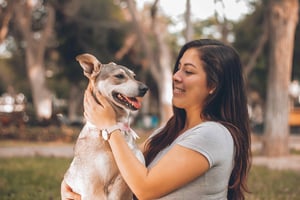Dogs are naturally affectionate animals, and one of the ways they show their love is through...
How to train a puppy: your complete guide
Puppies are curious little critters by nature, if you can work out their personality and when they’re most alert, training your puppy can be a breeze. Controlling your dogs’ behavior is vital to ensuring your best friend is kept safe in any situation, including when around other dogs.
Many people don’t know how to train a puppy or even where to begin, Fluffy is here to fix that issue by assisting you with the best training tips on the internet.
At what age should I start training my puppy?
The best time to start training your puppies is right from the minute you get them home, or if you are the breeder and have time to spare before they leave for their new homes, anywhere from 4 weeks old.
It is important to remember, however, that little dogs have the attention span of Dory. Yes, that is right, the blue fish with the big heart yet terrible memory from Finding Nemo.
What is the first thing I should train my puppy?
Basic commands like come, sit, lie down, heel, and stay are the go-to starting points for the first things you should train your puppy.
When it comes to the basic commands your dog should know, these few simple obedience-related terms are not only good for your pooch to learn, but will also save you from many varying disasters in the future.
-
Come: considered one of the most essential of commands. The “come” command protects him or her from traffic, neighbors, and encounters with other dogs.
-
Sit. This command is one of the easiest to teach and is usually the first command introduced to a dog or puppy. Learning this command also helps the dog learn how to respond to training.
-
Down. Another practical command is down (lay down). This is great for all dogs, but especially for large dogs.
-
Heel: There are many different training strategies you can use to teach your dog to walk by your side and to stop and sit when you stop moving.
-
Stay: The “stay” command comes in handy when you need your pup to stay put while you go to answer the door or sit down to wrap holiday gifts.
-
Off: This command is preferred to teach your dog that jumping on people or climbing on the furniture is inappropriate.
-
Don’t Touch: Teach them to let go of found treasures when you say “don’t touch” or “leave it.”
How do I teach my puppy the basic commands?
The foundation of training should be based on positive reinforcement. Positive reinforcement is the process of giving a dog (or person!) a reward to encourage the behavior you desire.
How to train your puppy the basic commands can be simple or difficult, it depends on how you approach the training.
It is important to remember that we can’t expect dogs to know what they don’t know – just like you wouldn’t expect a 2-year-old child to know of teaching how to tie his shoes.
Teach your puppy to come
When you call your puppy's name, it should be a cue for them to stop whatever they are doing, turn toward and acknowledge you, give you their undivided attention and wait for further instruction.
To do this, you must only use your puppy's name, utilizing positive reinforcement when they pay you attention and refrain from using their name for any other purpose.
Once you have their attention, and you are certain that your pup will obey, say the command “come”, or whatever word it is you wish to use. Ensure that you are more interesting than what they were interested in before.
Get down to your puppy's level, be excited and encouraging and when they come to you, praise them, make a fuss and offer a treat. This is how to positively reinforce coming to you when you ask. It is a case of wash, rinse, lather, and repeat, remember, consistency is key.
Teach your puppy to sit
Hold a treat close to your dog's nose. Move your hand up, allowing his head to follow the treat and causing his bottom to lower. Once he's in a sitting position, say “Sit,” give him the treat, and share affection.
You can also assist your puppy by placing gentle pressure over his/her hind end when teaching them to sit, this allows them to complete an action alongside what you are saying. Once again, reinforce their acceptance and obedience with a treat.
Teach your puppy to lay down
The technique for teaching a dog to lie down is similar to that for sitting and is also the precursor to teaching them to roll over.
When your puppy is sitting, place a treat near its nose, letting them snuffle it and maybe even lick the treat. Slowly try to lure his nose to the ground without actually giving him the treat.
Ensure that you have time to be patient with this exercise, and when your pup finally achieves the laying down position, make a fuss, praise them and offer them the treat.
Teach your puppy to heel
Teaching your puppy to heel goes hand in hand with leash training them and teaching them to come, you can combine the training and it makes it a lot easier and more fun, for both your furry pal and you.
Teaching your pup to heel or walk beside you, also inadvertently helps them learn to not pull on the leash.
Positive reinforcement with food is the best place to start
Showing your dog the treat, allowing them to sniff and almost taste the delicious snack to get their attention, then as you walk away say “heel” and lure them with the food.
The purpose of luring is to keep the pups' attention on you, at your side, so they don’t run off doing their own thing.
If they get distracted and move ahead of you, calmly but firmly say “no”, stop walking and bring them back to your side. Get their attention with the treat and repeat this process. As your pooch starts to understand and follow along, cease using the treats to lure and instead use them as a reward.
Teach your puppy to stay
Wait a minute, do you think I can get this little ball of activity with the attention span of Dory to actually sit and stay???
Yes, we all know that their attention span is somewhat short, and they have a hard time sitting still except for when they are exhausted. So teaching your puppy to stay can certainly test your virtues, but it is not impossible. It requires a lot of time and a great deal of patience on your behalf to teach your puppy to stay.
This basic command should be taken very slowly, starting out with your pup sitting by your side. Having a leash to assist you is a handy tool with this process.
Tell your pup to “stay”, and use the hand signal to stop if you so wish. Move around to the front of your puppy and repeat the command “stay”, but don’t move away. If your puppy remains still, repeat the command and move back to your puppys’ side.
If after this process they have managed to sit still, and quite possibly wonder what you are doing, make a fuss, give them praise and offer them a treat. Then give them a release command of your choosing, to let them know it is ok to move.
Repeat these steps consistently and increase the time and distance gradually over time. If they are struggling to maintain concentration, utilize your leash by looping it around an object to assist you with getting them to stay as you move away. As your puppy learns to stay using this method, you can reduce the use of the leash to the point where you don’t have to use it at all.
Teach your puppy the meaning of “off”
The best or shall we say most proven, way to teach your puppy the meaning of off? By using our best tactic, positive reinforcement, and the way to your pooches heart, of course being through their tummy ;)
Any time your dog jumps up, say “off.” Use a firm but kind voice, then move your puppy off. If they are persistent and are tending not to listen to this method, utilize your leash.
Step on the leash, allowing enough room for them to move but not enough that they can jump up onto you, and let the leash do the work—it should stop them in their tracks if they jump.
Use positive reinforcement once again, and when your puppy stops jumping, wait 10-20 seconds then reward them with praise and a treat.
Do not offer praise and treats too soon or it will be seen as a reward for jumping up.
Continue to repeat this process and as your puppy begins to understand the meaning of “off”, reduce the treats and offer praise only, as their reward.
Teach your puppy to “leave” or “don’t touch”
This can be a tricky command because most puppies a little gobble monsters and want nothing more than to swallow the treat you have on offer, whole.
Begin this training process with two treats, one the puppy values most over any other treat, and the other a little more boring, like a dry old biscuit.
Teach your puppy to leave, by first placing the biscuit in your hand and making a fist around it, hold your fist out for your puppy to sniff, allow them to snuffle your hand until they stop, and say “leave” or “don’t touch”.
Maintain this stance and the moment your puppy sits there quietly looking at you, offer praise make a fuss, and reward them with the tasty treat – like a piece of dried liver. So much tastier and reward-worthy than some old biccy.
Once your puppy understands this step and is displaying more consistent manners, begin teaching your puppy to leave by opening your hand and repeating the same process, remember to be quick in closing your fist around the treat if your puppys’ tastebuds take over, so they don’t grab the treat.
Repeat the command of your choice, and open your hand again. Rinse, lather and repeat, and remember, patience and consistency is key.
How much time should I spend training my puppy every day?
Aim for 3 training sessions per day, and up to 15 minutes per session. This is an optimum time frame as they are creatures of habit and you need to teach them how you wish for them to behave.
Dogs have a tendency to get bored easily, especially little puppies with so much exploring to do, which is why the time you should spend training your puppy every day is more about quality over quantity.



